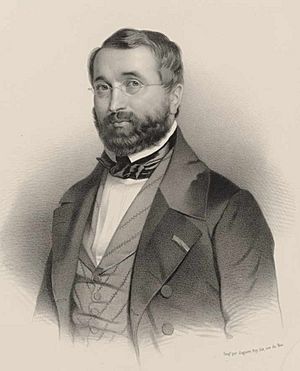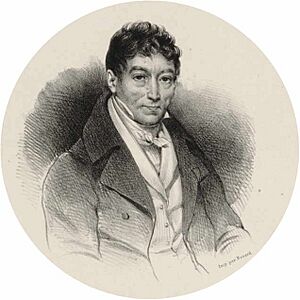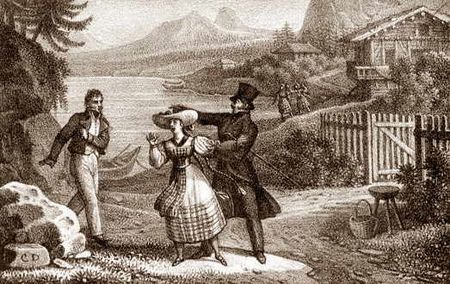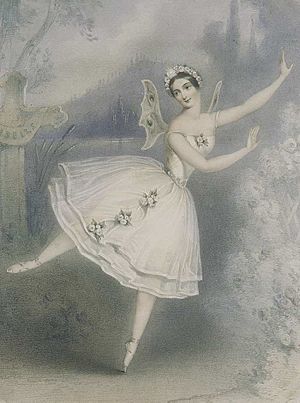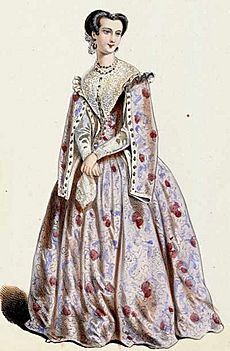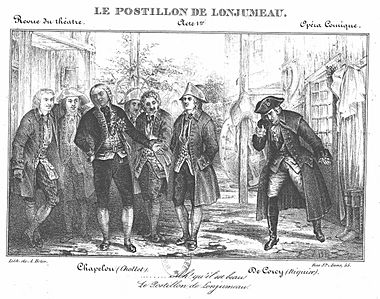Adolphe Adam facts for kids
Adolphe Charles Adam (born July 24, 1803 – died May 3, 1856) was a French composer, teacher, and music critic. He wrote a lot of music for the theater. Today, he is best known for his ballets Giselle (1841) and Le corsaire (1856). He also wrote the operas Le postillon de Lonjumeau (1836) and Si j'étais roi (1852). His Christmas song "Minuit, chrétiens!" (Midnight, Christians, 1844) is famous in English as "O Holy Night".
Adam's father was a well-known composer and pianist. However, his father did not want him to become a musician. Adam didn't listen to his father. He wrote many operas and ballets, which earned him a good living. But in 1848, he lost all his money. This happened when he tried to open a new opera house in Paris. It was meant to compete with the famous Opéra and Opéra-Comique. He recovered from this financial setback. He started working as a journalist and teacher. He became a professor at the Paris Conservatoire, which is France's main music school.
Adam, along with Daniel Auber and his teacher Adrien Boieldieu, helped create the French style of opera.
Contents
Life and Career
Early Years
Adolphe Adam was born in Paris on July 24, 1803. He was the older of two sons. His father, (Jean) Louis Adam, was a famous composer, pianist, and professor at the Paris Conservatoire. His mother, Élisa, was the daughter of a well-known doctor. She had been a student of Louis Adam.
Louis Adam gave his son music lessons. But Adolphe didn't want to learn the basics of music theory. Instead, he played music easily by ear. He later said he was never good at reading music quickly. His mother thought he needed strict schooling. So, he went to a boarding school called the Hix institute. It was known for both its academics and music.
When the French Empire fell in 1814–15, Louis Adam's income suffered. To save money, Adolphe was sent to a cheaper school. He still didn't like learning music theory or Latin.
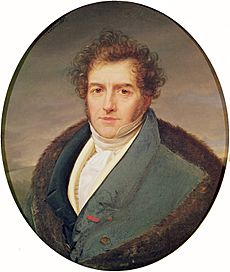
At age 17, Adam joined the Conservatoire. He studied organ, counterpoint (a type of music writing), and composition. His teacher, Adrien Boieldieu, was very important for Adam's musical growth. Boieldieu taught him to write long, beautiful melodies without using too many fancy musical changes.
Adam's father did not want him to be a professional composer. He wanted Adolphe to work in business or academics. His father gave him a place to live but no money for his music studies. By age 20, Adam was writing songs for Paris theaters. He also gave music lessons to earn money.
A man named Duchaume, who worked at the new Théâtre du Gymnase, offered Adam an unpaid job playing the triangle in the orchestra. Adam was happy to do it for free. He was soon promoted to a well-paying job. He said this was a big turning point in his life. He made friends with actors and writers.
In 1824, Adam entered the Conservatoire's important music competition, the Prix de Rome. He received a special mention. The next year, he won second prize. He also learned a lot by helping Boieldieu with his opera La Dame blanche. Adam's piano versions of songs from the opera were published in 1826. They earned him enough money to travel through Europe in 1826. In Geneva, he met Eugène Scribe, who wrote stories for operas. They later worked together on nine stage shows.
Early Successes
From 1824 to 1827, Adam wrote music for several short plays. In late 1827, Scribe wrote the story for Adam's first opera. It was a short, funny piece called Le Mal du pays, ou La Batelière de Brientz (Homesickness, or the Bargewoman of Brientz). It opened on December 28, 1827. A little over a year later, in February 1829, Adam's second short opera, Pierre et Catherine, was shown. It ran for more than 80 performances.
Seven months after Pierre et Catherine, Adam married Sara Lescot. She was a singer in a theater chorus. Their marriage was not happy, and they separated in 1835. Their only child, Léopold-Adrien, was born in 1832 and died in 1851.
Adam's first full-length operas came out in 1829. They were Le jeune propriétaire et le vieux fermier and Danilowa. Danilowa was doing well until the July Revolution in Paris caused problems. This, and an outbreak of cholera, made Adam move to London. He went at the suggestion of his brother-in-law, Pierre François Laporte, who managed the King's Theatre. In 1832, Laporte leased the Theatre Royal, Covent Garden. In October, Adam's music was used for a military show called His First Campaign. It was very popular. But his next show, The Dark Diamond, was not as successful. Adam returned to Paris in December. He briefly went back to London in 1833 for his ballet Faust.
Peak Career
In 1834, Adam had a huge success with Le chalet at the Opéra-Comique. This was a short, funny opera. It was performed over 1000 times in Paris in the next 40 years. In May 1836, Adam received a special award called the Legion of Honour. His first work for the Paris Opéra was a ballet, La fille du Danube. It starred the famous dancer Marie Taglioni in September 1836. Soon after, his three-act comic opera Le postillon de Lonjumeau opened successfully. This opera was his biggest success around the world. It was performed in London in 1837 and New York in 1840.
In 1838 and 1839, Adam wrote music for a ballet called Les Mohicans and four operas. In September 1839, he traveled to St Petersburg, Russia. His ballet L'Écumeur de mer (The Pirate) was performed for the royal family. Two of his operas were also staged there. He left Russia in March 1840, stopping in Berlin. There, he wrote and conducted an opera-ballet called Die Hamadryaden (The Tree Nymphs).
Adam's next big work was the ballet Giselle, which is his most famous piece. It was based on an old story. Giselle premiered at the Opéra on June 28, 1841. Carlotta Grisi danced the main role. Adam continued to write a lot of music. This included his first grand opera, Richard en Palestine, in 1844. But it wasn't very popular. That same year, he joined the Académie des Beaux-Arts, a famous arts academy.
Financial Disaster
In 1845, the director of the Opéra-Comique, François-Louis Crosnier, left his job. Alexandre Basset took over. Basset soon had a disagreement with Adam. He told Adam that his works would never be performed at the Opéra-Comique while he was director.
In early 1847, a theater became available. Adam, with an actor named Achille Mirecour, took it over. They renamed it the Opéra-National. The cost to fix up the theater was huge. Adam invested his own money and borrowed a lot more. The new opera house opened in November 1847. But it didn't look like it would succeed from the start. It didn't make much money, and the shows weren't very good. The 1848 Revolution was the final blow. The new government closed the theaters. When they reopened, few people wanted tickets for Adam's opera house. It closed on March 28, 1848, after only four months. Adam had lost all his money.
To pay off his debts, Adam used the money he earned from his earlier works. Like many other French composers who needed money, he started writing for newspapers. He wrote reviews and articles. He also became a teacher, accepting a job as a professor of composition at the Conservatoire. One of his students was Léo Delibes. Meanwhile, Basset had left the Opéra-Comique. So, Adam was able to return to the place where he felt most comfortable working.
Last Years
In July 1850, Giralda, one of Adam's best operas, was performed at the Opéra-Comique. In 1851, his wife, who he was separated from, died. Adam then married the singer Chérie-Louise Couraud (1817–1880). They lived together for the rest of his life. For the Théâtre-Lyrique, which was the new version of his failed Opéra-National, Adam wrote the successful Si j'étais roi. It was first performed in September 1852. That year, he created six new works. This helped him pay off all his debts.
During his last three years, Adam continued to compose a lot of music. His later works include one of his best ballets, Le Corsaire. It was based on a poem by Byron. It was performed at the Opéra in January 1856. His very last stage work was a short, light opera called Les Pantins de Violette (Violette's Puppets). It was performed on April 29, 1856. Four nights later, Adam died in his sleep at age 52. He was buried in the Montmartre Cemetery.
Works
Many of the pieces Adam wrote didn't last long. This includes the popular songs he wrote for plays in his early years. He also made many piano versions and mixtures of popular opera songs. However, some of his operas and ballets are still loved today. They are not just good examples of their type, but also full of truly creative music.
One example is Le chalet. It includes music from a song he wrote for a competition in 1825. Music experts say it's one of Adam's best works because of its new and exciting ideas. Music historian Theodore Baker says Adam, along with Auber and Boieldieu, helped create French opera. This is because his melodies showed feelings well, and he was good at telling a story through music.
In France, Le chalet was Adam's most popular opera during his lifetime and after. In other countries, Le postillon de Lonjumeau was the favorite. In Germany, this opera was especially famous for a tenor song with a difficult high note. Experts say the opera has unique and well-developed characters. It also shows Adam's good understanding of how to make a show exciting. Of his later operas, Giralda and Si j'étais roi are considered the most stylish and tuneful.
Adam wrote a lot of operas, but he wrote ballet music even more easily. He said it was fun, not work. Giselle is his most famous ballet. Baker calls it a major work in the history of dance, still performed with great success. Experts say that while Giselle has a very memorable story, his other ballets like La jolie fille de Gand, La filleule des fées, and Le corsaire are just as good musically.
Most of Adam's religious music is not performed often. The main exception is his Christmas song, "Minuit, chrétiens!", known in English as "O Holy Night".
Adam's memories were published after he died in two books: Souvenirs d'un musicien (1857) and Derniers souvenirs d'un musicien (1859).
See also
 In Spanish: Adolphe Adam para niños
In Spanish: Adolphe Adam para niños


